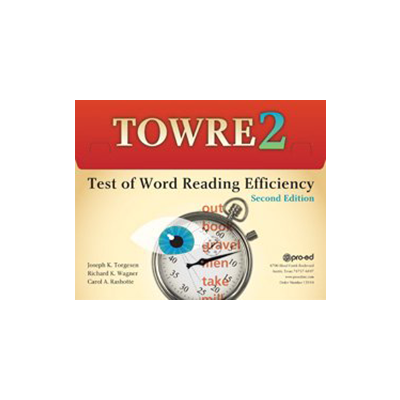Joseph Torgesen, Richard Wagner, Carol Rashotte
Age Range:6:0-24:11
Completion Time:5-10 minutes
Publication Date:2012
The Test of Word Reading Efficiency–Second Edition (TOWRE–2) is a measure of an individual’s ability to pronounce printed words (Sight Word Efficiency) and phonemically regular nonwords (Phonemic Decoding Efficiency) accurately and fluently. Because it can be administered very quickly, the test provides an efficient means of monitoring the growth of two kinds of word reading skill that are critical in the development of overall reading ability.
TOWRE-2 Subtests
- Sight Word Efficiency (SWE): Assesses the number of real printed words that can be accurately identified within 45 seconds.
- Phonetic Decoding Efficiency (PDE): Measures the number of pronounceable printed non-words that can be accurately decoded within 45 seconds.
Each of the two subtests of the TOWRE–2 has four alternate forms, A through D. The four forms of each subtest are of equivalent difficulty, and any of the forms of each subtest may be given depending on the purposes of the assessment. If only one form of each test is used, the test can be administered in approximately 5 minutes, including time for directions and practice items.
Norms
The TOWRE–2 was normed on over 1,700 individuals ranging in age from 6 to 24 years and residing in 12 states and Washington, DC. Over 700 children in the norming sample attended elementary school (through Grade 5), where the TOWRE–2 is expected to have its widest use. The average alternate forms reliability coefficients (content sampling) for the subtests exceed .90. The average test–retest (time sampling) coefficients for the same form exceed .90. The average test–retest (time sampling) coefficients for different forms of the subtests are .87. The magnitude of the coefficients reported from all the reliability studies evidenced little measurement error in the TOWRE–2. The numerous reliability and validity studies presented in the manual provide the examiner with strong evidence concerning the strengths and limitations of the scores provided by the test.
Uses for the TOWRE–2
The current edition of the TOWRE has been widely used for three different purposes:
- Early identification. The TOWRE–2 can be used in identifying children in the early elementary grades who will require more intensive or explicit instruction in word reading skills in order to make adequate progress in learning to read.
- Diagnosis of reading disabilities. The test is also being widely used as part of a battery of tests for diagnosis of specific reading disabilities in older children and adults. The TOWRE–2 can be used either as a replacement for or as a supplement to standard diagnostic tests of context-free word reading ability currently in use.
- Research. Since its publication in 1999, the TOWRE has been widely used in research as a quick and reliable assessment of word-level reading skills in both large and small research populations.
We hope that the TOWRE–2, with the creation of two additional test forms (Forms C and D) for each subtest, will have at least one additional use beyond those already enumerated. The report of the National Reading Panel in 2000 indicated that frequent monitoring of growth in essential reading skills is important in the delivery of effective reading instruction for all students. Frequent assessment of critical reading skills is also a central aspect of the popular Response to Intervention model of service delivery. Although the TOWRE–2 has not been developed to provide weekly or monthly assessments, it certainly can be used to monitor progress in growth of word-level reading skills three or four times per year.





